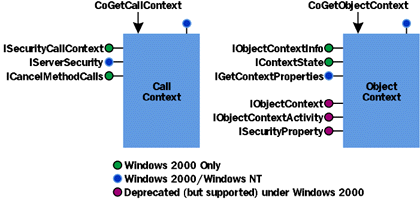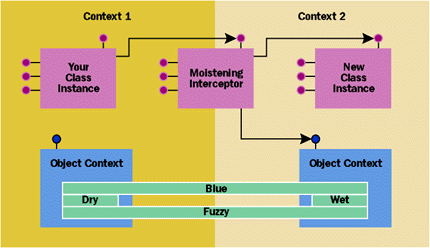September 1999
![]()

|
Don Box is a co-founder of DevelopMentor, a COM think tank that educates the software industry in COM, MTS, and ATL. Don wrote Essential COM and coauthored the follow-up Effective COM (Addison-Wesley). Reach Don at http://www.develop.com/dbox. |
|
I've spent the last 12 months of my life thinking,
explaining, and writing about context. Developers
often come up to me and ask, "Are contexts real?" My usual reply is that contexts are as real as processes or threads. Ultimately, processes and threads are OS-level abstractions that have a supporting API and underlying implementation. Contexts (and activities, apartments, and transaction streams) are COM-level abstractions that also have a supporting API and implementation.
For a lot of folks, seeing a concrete example goes a long way toward understanding a technology, so this month's column tries to pull back the curtain and look at a prototypical implementation of COM+. Be aware that the implementation presented here is by no means based on the actual code used in Windows 2000®—rather, it is a radically simplified version meant to illustrate the semantics of COM+. Before I start looking at code, it is important to define context. In COM+, like Microsoft® Transaction Server (MTS) before it, a context is the innermost scope of an object. All objects exist in a particular context. Additionally, object references are context-relative and only usable from the context they are initialized in. To pass object references from one context to another, you can either pass the reference as a method argument to some other object (this is the recommended way) or by using CoMarshalInterface/IGlobalInterfaceTable to context-neutralize the reference prior to sharing it across context boundaries. In general, an object is associated with a context at CoCreateInstance time, and CoCreateInstance is the primary creator of new contexts. Contexts have properties that are determined by the attributes of the newly instantiated object's class. Additionally, the context properties of an object's creator can also factor into the new object's context. Contexts subdivide a process into mini-processes and share many of the same characteristics of a Win32®-based process (such as property inheritance). Call Context Versus Object Context
|
 |
| Figure 1 Context Object Model |
|
In many ways, CoGetObjectContext is analogous to the Win32 API GetCurrentProcess. Both APIs return a reference to the current runtime environment. GetCurrentProcess can cheat by simply returning a pseudo-handle that the system recognizes as meaning "the current process" whenever it is passed to a system call. Because CoGetObjectContext must return a valid COM object reference with vptrs and vtbls, some other approach is needed. Enter interceptors. Interceptors
Drilling into the interceptor, consider the minimalist implementation shown here: Since user-defined objects do not have any facility for maintaining a reference to their context, the interceptor must somehow make the context available to the method while it executes (hence the CoGetObjectContext API). To achieve this, the interceptor and CoGetObjectContext must conspire to build the concept of the "current" context, which the interceptor must set up prior to invocation and restore when invocation is complete. To implement the notion of current context, each thread needs a thread local storage (TLS)-based reference to an object context. Implementing OBJECT_CONTEXT
|
 |
| Figure 3 Context Property Propagation |
To understand how CoCreateInstance works, let's take a look at a simplified implementation that focuses on the interesting bits.
Because CoCreateInstance wants the new object to inherit as many context properties as possible, CoCreateInstance checks the target class to see if it is possible to share all of the context properties. If it is, then there is no reason to create a new context for the object. Rather, the new object can simply share the context of the creator. The pseudocode for TotallyCompatible is shown in Figure 4. The code in Figure 4 illustrates three important facts:
With the TotallyCompatible function in place, let's look at SimpleCreate and ComplexCreate. As the name implies, SimpleCreate is the simpler, so let's look at it first: Unlike SimpleCreate, ComplexCreate has to perform context magic. Recall that ComplexCreate is called when the target class mandates that a different context be used. If the target class is a configured class, then a new context will be created. However, the target class may be a nonconfigured class in the case of apartment incompatibilities (more on this later). The basic implementation is shown in Figure 5. Recall that the code in Figure 5 is called when the new object must live in a different context than its creator. Note that this code simply finds or creates the child context and creates an interceptor that binds the new object to the child context. As you saw earlier, this interceptor will ensure that when methods of the new object are invoked, the "current" context will be the child context, not the caller's context. The function FindContext is responsible for propagating context properties from the parent to the child. It must look at the target class's attributes (which are read from the component catalog) and the context of the creator. In general, you want all of the context properties to propagate, barring attributes that prohibit it. Here's the pseudocode: Propagation
Transaction stream propagation is very similar to activity propagation. The primary difference is that transaction streams need to keep track of which context is the root, as the root is treated specially with respect to transaction termination (more on this in a future column). You'll find the transaction propagation pseudocode in Figure 7. Note the striking similarity between this function and the PropagateActivity function. Apartment propagation is a bit more complex than either of the two properties examined so far. Recall that each process has several distinguished apartments. The multithreaded apartment (MTA) is the apartment a thread enters when it calls CoInitializeEx(COINIT_MULTITHREADED). The thread-neutral apartment (TNA) is the apartment that no thread resides in, but any thread can enter (more on this next time). The main apartment is the first single-threaded apartment (STA) to be created in a process. Finally, the host apartment is a COM-managed STA used to house ThreadingModel=Apartment objects created by MTA threads. Classes control which apartments they can execute in via their ThreadingModel setting. The legal values for ThreadingModel are:
Let's look at the second function, GetHomeAptOfThread. This function assumes that there is a thread-specific variable declared as follows: The entire reason for describing the notion of a home apartment per thread was to examine the case of a CoCreateInstance call against a ThreadingModel=Apartment class. By reexamining the PropagateApartment routine, you can see that if the caller's thread calls an STA home, the new object lives in the calling thread's home apartment. If, on the other hand, the caller's thread calls the MTA home, the new object lives in the host STA apartment of the process. It is important to note that a current apartment is somewhat different than the home apartment of a thread. In essence, one cannot safely make the following assertion: Apartments and Contexts
The default context of an apartment houses instances of nonconfigured classes only. It is used in two common scenarios. First, if a thread that is simply sitting idle in the default context calls CoCreateInstance against a nonconfigured class that is ThreadingModel-compatible with the thread's home apartment, the new object will reside in the default context of the calling thread. Second, the default apartment is used when CoCreateInstance is called against a nonconfigured class that is ThreadingModel-incompatible with its creator. (Look at the FindContext code shown earlier for an example of where this happens.) In this case, COM will put or create the new object in the default context of the appropriate apartment. Here's the pseudocode for GetDefaultCtxOfApt: Finally, two similar-looking functions were referred to in this column, but never defined. The function ApartmentCompatible was called indirectly by CoCreateInstance to determine whether a target class could share the apartment property of its creator. Its implementation is fairly simple: The second function, ThisThreadCanEnterCtx, was called to determine whether a given thread could enter a context. This function uses the home apartment of the calling thread to determine whether entry into the apartment is possible without a thread switch. Its implementation is shown here: Conclusion
|
|
Have a question about programming with COM? Send your questions via email to Don Box: dbox@develop.com or http://www.develop.com/dbox. |
|
From the September 1999 issue of Microsoft Systems Journal.
|